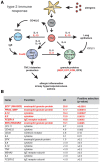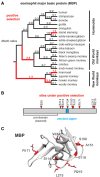Rapid Evolution of Primate Type 2 Immune Response Factors Linked to Asthma Susceptibility
- PMID: 28854632
- PMCID: PMC5569703
- DOI: 10.1093/gbe/evx120
Rapid Evolution of Primate Type 2 Immune Response Factors Linked to Asthma Susceptibility
Abstract
Host immunity pathways evolve rapidly in response to antagonism by pathogens. Microbial infections can also trigger excessive inflammation that contributes to diverse autoimmune disorders including asthma, lupus, diabetes, and arthritis. Definitive links between immune system evolution and human autoimmune disease remain unclear. Here we provide evidence that several components of the type 2 immune response pathway have been subject to recurrent positive selection in the primate lineage. Notably, substitutions in the central immune regulator IL13 correspond to a polymorphism linked to asthma susceptibility in humans. We also find evidence of accelerated amino acid substitutions as well as gene gain and loss events among eosinophil granule proteins, which act as toxic antimicrobial effectors that promote asthma pathology by damaging airway tissues. These results support the hypothesis that evolutionary conflicts with pathogens promote tradeoffs for increasingly robust immune responses during animal evolution. Our findings are also consistent with the view that natural selection has contributed to the spread of autoimmune disease alleles in humans.
Keywords: asthma genetics; eosinophil granule protein; human variation; interleukin 13; primate evolution.
© The Author 2017. Published by Oxford University Press on behalf of the Society for Molecular Biology and Evolution.
Figures




Similar articles
-
Correlated evolution of nucleotide substitution rates and allelic variation in Mhc-DRB lineages of primates.BMC Evol Biol. 2009 Apr 12;9:73. doi: 10.1186/1471-2148-9-73. BMC Evol Biol. 2009. PMID: 19361342 Free PMC article.
-
Antimicrobial Functions of Lactoferrin Promote Genetic Conflicts in Ancient Primates and Modern Humans.PLoS Genet. 2016 May 20;12(5):e1006063. doi: 10.1371/journal.pgen.1006063. eCollection 2016 May. PLoS Genet. 2016. PMID: 27203426 Free PMC article.
-
Immune and genetic aspects of asthma, allergy and parasitic worm infections: evolutionary links.Parasite Immunol. 2009 May;31(5):267-73. doi: 10.1111/j.1365-3024.2009.01104.x. Parasite Immunol. 2009. PMID: 19388947 Review.
-
Interleukin 13 and interleukin 4 receptor-α polymorphisms in rhinitis and asthma.Int Arch Allergy Immunol. 2010;153(3):259-67. doi: 10.1159/000314366. Epub 2010 May 19. Int Arch Allergy Immunol. 2010. PMID: 20484924
-
The gene encoding interleukin-13: a susceptibility locus for asthma and related traits.Respir Res. 2000;1(1):19-23. doi: 10.1186/rr7. Epub 2000 Jul 17. Respir Res. 2000. PMID: 11667960 Free PMC article. Review.
Cited by
-
The influence of evolutionary history on human health and disease.Nat Rev Genet. 2021 May;22(5):269-283. doi: 10.1038/s41576-020-00305-9. Epub 2021 Jan 6. Nat Rev Genet. 2021. PMID: 33408383 Free PMC article. Review.
-
Dynamic Evolution of Bacterial Ligand Recognition by Formyl Peptide Receptors.Genome Biol Evol. 2023 Oct 6;15(10):evad175. doi: 10.1093/gbe/evad175. Genome Biol Evol. 2023. PMID: 37776517 Free PMC article.
-
Gene expression variability across cells and species shapes innate immunity.Nature. 2018 Nov;563(7730):197-202. doi: 10.1038/s41586-018-0657-2. Epub 2018 Oct 24. Nature. 2018. PMID: 30356220 Free PMC article.
-
C5 and SRGAP3 Polymorphisms Are Linked to Paediatric Allergic Asthma in the Italian Population.Genes (Basel). 2022 Jan 25;13(2):214. doi: 10.3390/genes13020214. Genes (Basel). 2022. PMID: 35205259 Free PMC article.
References
-
- Abascal F, Zardoya R, Posada D.. 2005. ProtTest: selection of best-fit models of protein evolution. Bioinformatics 21:2104–2105. - PubMed
Publication types
MeSH terms
Substances
Grants and funding
LinkOut - more resources
Full Text Sources
Other Literature Sources
Medical

